Golf Performance Process–A Step-By-Step Guide
Have you ever noticed how the big league golfers acts similarly on the green? Each one strolls calmly to the next shot, spends ample time observing the ball, and keeps quiet before taking their swing.
You might boil their copycat behavior down to simple logic: “Of course you need to be quiet before a shot,” or, “Why run to the next ball? They need to keep calm.” In that case, you are right.
But, beyond that, every moment before, during, and after a shot is broken down into small and extremely intentional actions, resulting in better shots.
There is a process to good golf performance, and we are going to walk you through every step, so you can approach each stage with confidence.
Process Makes Perfect
At Integrity Golf Performance, we broke this process into pieces, so you can easily visualize yourself in each phase and adjust your mind and your body.
Let’s start at the beginning. The yellow circle in the middle represents the process, since every part of the golf performance revolves around it.
Our goal? Performance optimization.
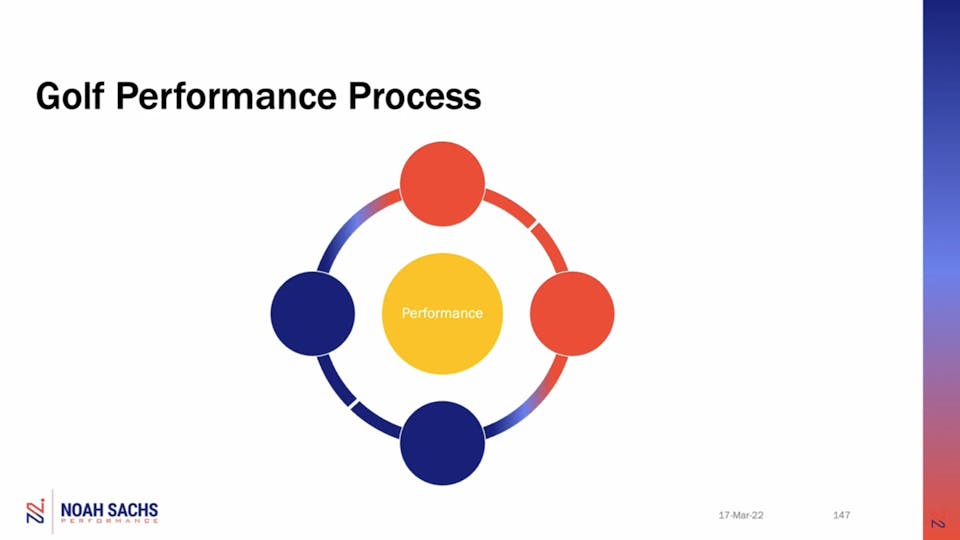
The orange circles represent the pre-shot phase. The first element is the decision routine, and the second element is the execution routine.
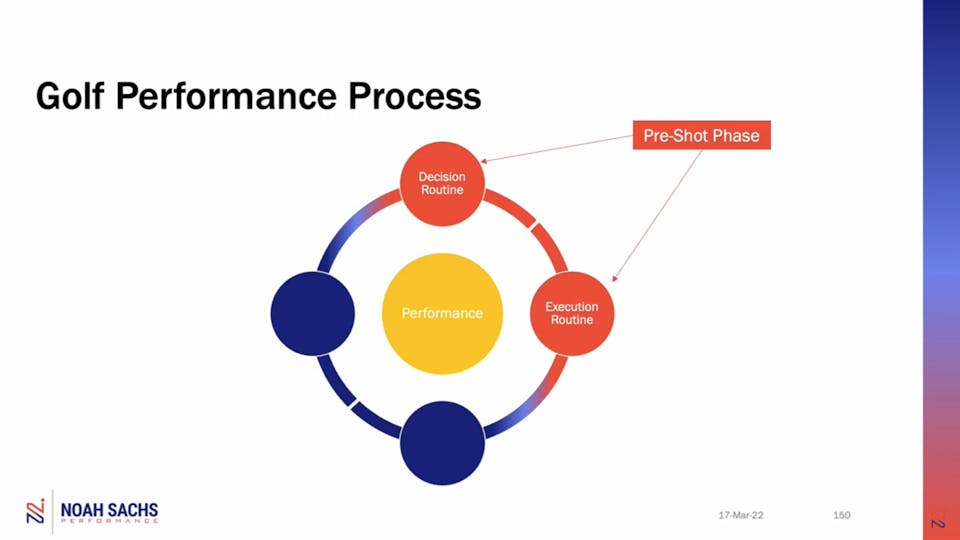
The blue circles represent the post-shot phase. The first element is called the reflection routine, and the second element is transition habits.
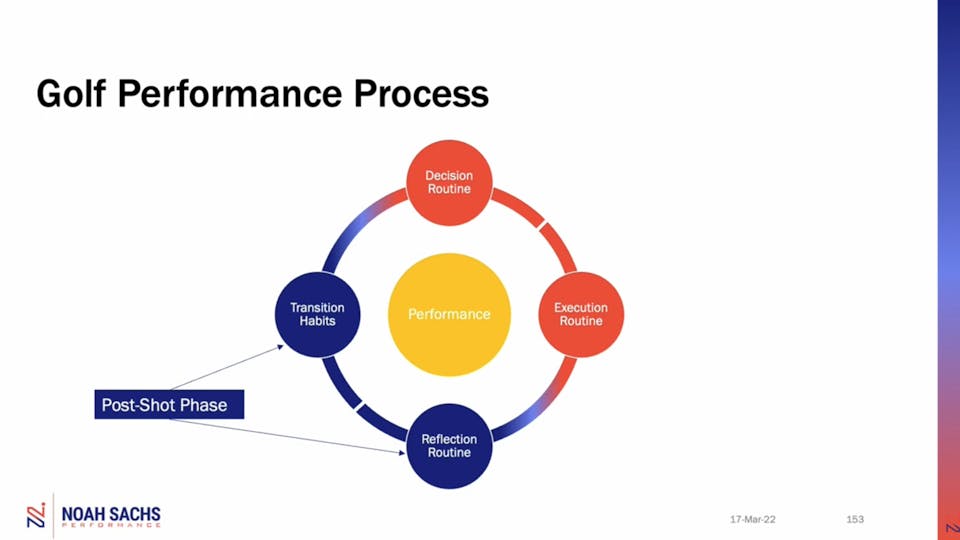
The white line that interrupts the solid orange line represents the end of the decision routine and the start of the execution routine.
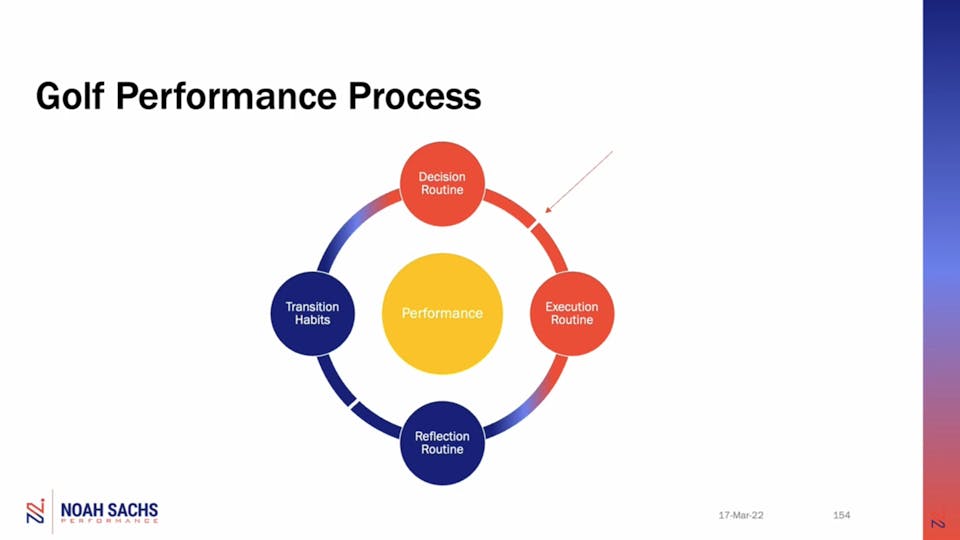
The white line that interrupts the solid blue line represents the end of the reflection routine and the start of transition habits.

There is no white line between the orange and blue circles; instead, a color gradient represents the gradual transition between the phases.
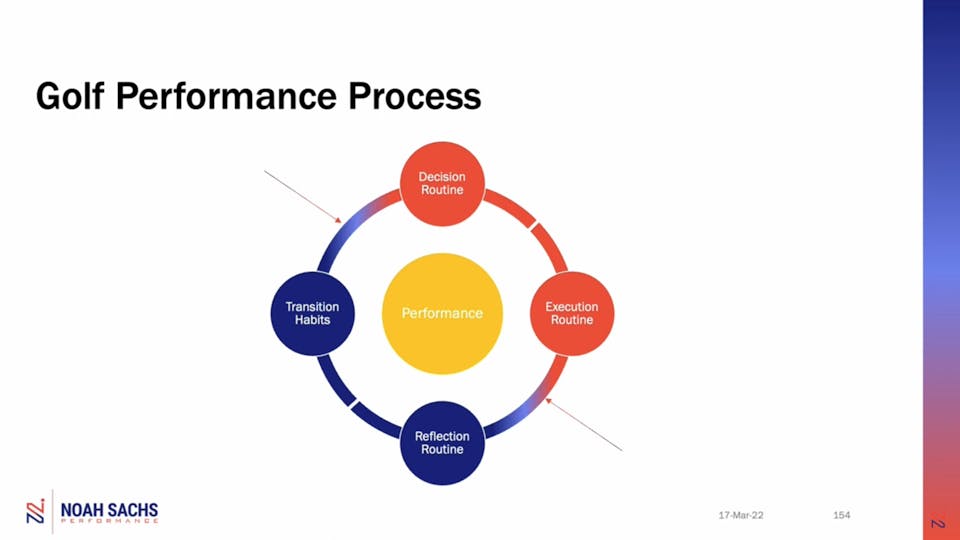
Each of the routines and habits has a beginning and an end, but they all contribute to an ongoing process that revolves around performance.
Pre-Shot Phase
We divided each phase into four elements: goals, tools, timing, and characteristics.
Let’s start from phase one and work our way to the end goal.
Element One–Decision Routine
Goal:
- Decide what action to take.
Tools:
- Decade System.
- Practice swings.
- Yardage book.
- Caddy.
Each of these tools helps you decide what type of shot you want to play.
Timing:
- Approaching ball/tee box.
- Initial moments upon arrival at the ball/tee box
Characteristics:
- Talking.
- Rapid movements.
- Analytical (thinking).
During the decision routine, you may talk to yourself or with your caddy; there might be rapid movements such as crouching down or full-speed practice swings.
The decision routine is analytical; you are thinking to make the right decisions for the upcoming shot.
Remember that talking and making rapid movements increase sympathetic system activity. At this point, that’s fine and dandy; however, we want to avoid excessive sympathetic activity, if possible.
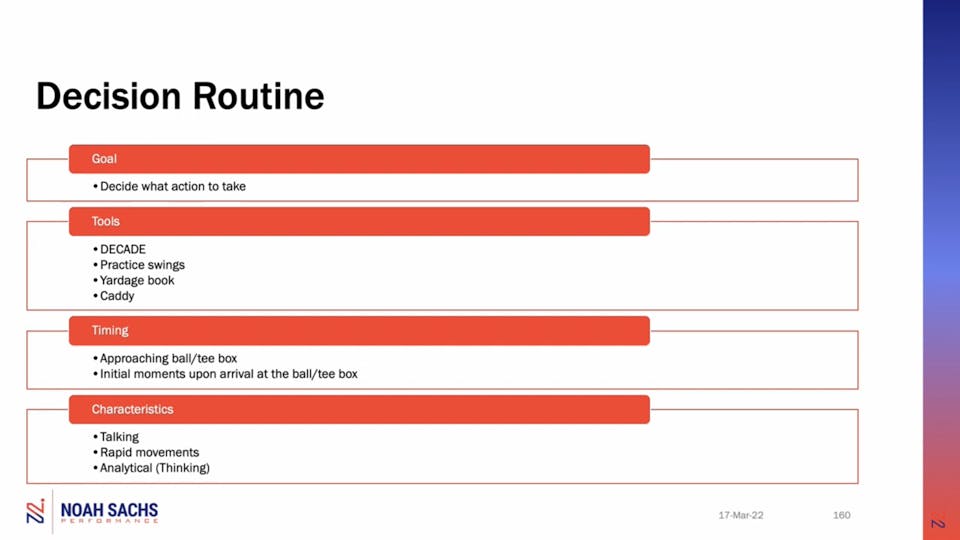
Element Two–Execution Routine
Goal:
- Execute the shot based on the decision made during the decision routine.
- Counteract the sympathetic activity that accumulated during the decision routine.
Tools:
- Resonance frequency breathing.
Timing:
- Once you’ve completed the decision routine.
- Ends once you’ve hit the shot.
Characteristics:
- Silence.
- Slow movements.
- Deliberate movements.
- Perceiving (feeling).
There is complete silence during the execution routine, and the movements are slow and deliberate, since our agenda is to perceive and feel.
In this phase, to execute the shot from an ideal physiological state, we want to combine parasympathetic system activity with a mental focus on the present moment.
It’s important to tell our bodies, “I am not in a life-threatening situation,” so that we don’t produce a physiological stress response.
In addition to resonance frequency breathing, a tool we can use during the post-shot phase is called breath holds.
Breath holds help us bring our attention to the present moment and increase our alertness when we feel frustrated after a bad shot, or when our minds start wandering during a round.
In that case, we can use a combination of breath holds and resonance frequency breathing to bring our attention back to the present moment.
Breath holds trigger a sympathetic system response in the body, which is why you don’t want to use them right before performing a shot (that’s why this tool is not used during the pre-shot phase).
Congratulations, you’ve made it this far. That concludes phase one; let’s move on to phase two–the post-shot phase.
Post-Shot Phase
In this phase, we reflect on the dos and don’ts of the pre-shot phase.
Element One–Reflection Routine
Goal:
- Identify relevant information for future decisions.
- Return to a parasympathetic state.
- Increase present moment awareness.
For example, for goal one, after our shot, we could learn about the speed of the green or how the weather is impacting the speed of the ball in the air.
In relation to goal two, it is normal to get excited or frustrated according to the shot’s outcome–that’s OK in the initial moments after the shot. However, we want to return to a parasympathetic state as soon as possible.
Whether we are playing well or poorly, our mind might start wandering, but we must quickly refocus our attention on the present moment to meet goal three.
Tools:
- Resonance frequency breathing.
- Breath holds.
Resonance frequency breathing helps us activate the parasympathetic nervous system, which produces our physiological stress response. Breath holds help us bring our attention to the present moment and stop our minds from wandering.
Timing:
- Once the swing/stroke has been made.
Characteristics:
- Silence.
- Slow movement.
- Deliberate movement.
Element Two–Transition Habits
We’ve arrived at the last (but not least) phase of the process. Don’t lose your focus, and take note of the following.
Goal:
- Parasympathetic signals to the body to counteract upcoming sympathetic signals.
Talking, eating, drinking, and perhaps strenuous exercise are activities that we will have to do at specific points during the round.
We want to pre-emptively counteract the sympathetic signals that those activities send to the body by having good breathing habits during our transition from one shot to the next.
Tools:
- Resonance frequency breathing.
- Breath holds.
Timing:
- Between the completed reflection routine and the next decision routine.
Characteristics:
- Precisely time sympathetic activities (e.g. drinking, talking).
- Slow movements.
- Deliberate movements.
During the transition phase, we want to plan when to deliberately engage in activities that create a sympathetic system response and the times when we are eating, drinking, or talking.
For example, it wouldn’t be ideal to talk with your playing partner up the entire fairway, then gulp some water and eat a snack right as you arrive at your ball–that’s what we would call a lousy transition habit!
Instead, we might briefly snack or take a sip of water immediately after completing our reflection routine, and then silently walk towards our ball while doing resonance frequency breathing.
When we aren’t eating, drinking, or talking, we want our movements to be slow and deliberate.
There’s a Science to Success
If you recognize that you’ve been playing a very unintentional game and want to step it up, Integrity Golf Performance is the place for you.
Our kinesiologist and experts will train you to master each step in the process, so that, in no time, you will see an improvement in your game and gain confidence as a player.
If that’s your aim, feel free to contact us today for an appointment with our experts to get the ball rolling–or flying!
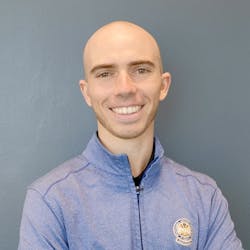
Are you ready to improve your game?
Book your assessment today by clicking the button below. We'll call you to schedule your visit.
